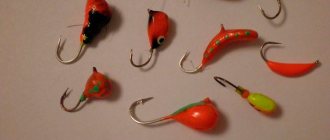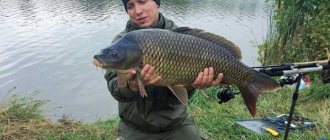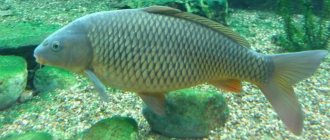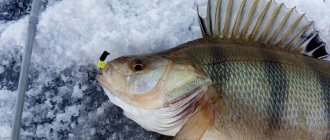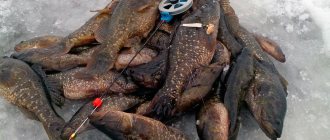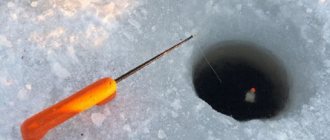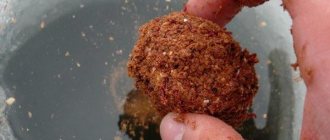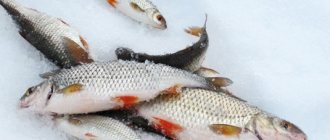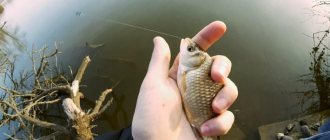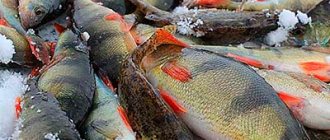Suitable rods and reel
You can catch carp in the summer with a variety of gear, both bottom and float.
If you choose among float gear, the choice will be influenced by both the characteristics of the fishing conditions and the expected size of the fish. If promising points on a reservoir are located close to the shore, and the weight of the expected catch does not exceed 2 kilograms, then you can get by with the simplest fly rod (you can also use a Bologna). If casting is difficult due to aquatic or terrestrial vegetation, then the best option would be a plug, which, with the correct selection of fishing line and rubber shock absorber, allows you to fight quite large fish. If you need to cast a float rig as far as possible, it is better to pay attention to match rods - the longest-range among float rods, which are also quite capable of coping with large carp. Reels are required only for Bolognese and match rods; usually these are inertia-free up to size 3000 with a small spool and a high gear ratio.
https://www.youtube.com/watch{q}v=lcyConmrlqI
Among the bottom rods for carp fishing, you can choose either a specialized carp version or a feeder with a suitable test and length. Carp rods have a significant margin of safety and allow you to easily handle even large specimens, but many fishermen prefer more delicate feeder gear, which can provide more pleasure during the fishing process. The reel is matched to the fishing rod, in the case of feeders these are mainly sizes from 4000 to 6000, while carp reels are usually larger, their sizes start from 5000 and can reach 10000, and sometimes more.
Photo 1. Battery of carp rods.
Fishing with a jig puts forward a number of requirements for the rod that will be used to animate the bait.
. These criteria include fly and Bolognese fishing rods, as well as long spinning tackle with small test parameters. Graphite, composite and carbon fiber are the materials from which lightweight yet durable fishing rods are made. Since the hunting process can be carried out both from a boat and from the shore, you need to understand that different conditions will require different lengths of gear. From boats, fishing rods no longer than four meters are used.
The telescopic assembly method adds mobility when transporting and assembling gear.
Promising places
Unlike other periods, winter brings additional problems and difficulties into the everyday life of fishermen. The success of the upcoming process is closely related to the endurance and patience shown, because in cold times the fish is very capricious, so sometimes it simply does not bite. In addition, carp is considered the most heat-loving inhabitant of the depths, which treats the arrival of winter as a stressful environment. However, with the right approach, you can catch it even in frosty winter, when weather conditions become unbearable.
To understand how to catch carp in winter, you need to have a general understanding of its habitats at this time of year. You cannot make a mistake in finding a suitable fishing spot, because this can turn fishing into a pointless waste of time. After all, even in summer, this capricious representative of the ichthyofauna hardly bites at the slightest cold snap, and what can we say about winter, when the weather changes almost every hour. Therefore, an important component of the success of winter fishing is the choice of location.
Reservoir depth
It is important to understand that with the advent of cold weather, fish move en masse to the deepest parts of the reservoir, so you only need to look for them there. If we are talking about a large reservoir or lake, then finding holes in it will not be difficult. If the question is: how to catch carp in winter on a small pond, then look for a decent depth near the dams.
Regardless of the size of the reservoir, the minimum depth for fishing should be at least two meters. As an exception, there may be small ponds where there are no depressions or holes, and the bottom topography is relatively uniform.
As for other fishing spots, the fish stay in the depressions with a comfortable temperature, practically not going out into shallow water. Only with the arrival of thaws does it periodically swim up to the coastline to warm up and “breathe.”
When looking for a good place to set up a hole, you need to take into account the carp’s love for all kinds of shelters. Like other shy representatives of aquatic fauna, this resident loves to arrange shelters for himself among snags, trees that have fallen into the water and other obstacles. If you manage to find such a water area, then success is guaranteed.
Favorite hiding places
Very often, carp can be found in areas near hydroelectric power stations, where there are high water levels and heated water. The heat-loving inhabitants like such places the most.
But hydroelectric power stations are not installed on every body of water, although there is an alternative source of heat - flowing streams. It is near them that there are large concentrations of hungry fish that want to stay warm. Near streams, the temperature marks are always several degrees higher, so the carp senses this difference and stops there.
If you know areas where there are gushing springs, this will also increase the chances of a good catch. Finding them is not difficult, because in such places the ice is always thinner. By the way, many fishermen determine the location of underwater sources in the warm season. To do this, you need to dive under the water and swim half a meter from the bottom. The presence of a spring will be confirmed by the feeling of a cold stream.
To successfully find winter carp sites, you need to conduct various experiments, fish different areas, and also be patient. In this case, the effort spent will definitely be justified by a good bite. Well, we must not forget about the density of fish in the reservoir, which also affects the frequency of bites. If there are a lot of carp, then it will definitely show itself and start biting. If its population is minimal, it is better not to waste time and start catching other prey.
Summing up the search for promising places for fishing, you need to pay attention to the following features:
- The fish often stays in deep holes and depressions.
- It can be found near dams and where hydroelectric dams release warm water.
- The places where streams flow into the reservoir and the presence of gushing springs are very attractive to carp.
- Snags, flooded objects and trees also arouse special interest among the heat-loving resident.
When going fishing in winter, don't stay at one hole for too long. Try to change your fishing location every half hour without a bite.
Equipment
Summer fishing with a jig is equipped in two main directions, directly related to the depth of the reservoir where the fish is caught. The fishing rod can be equipped with a blind method or a running method. The blind method involves the use of a certain cut of fishing line, covering the parameters of the depth already known in the reservoir, not exceeding the length of the fishing rod blank. Running equipment is equipped with a reel, often of an inertial type with a locking mechanism, based on Bolognese gear, and has a supply of fishing line that is several times greater than the length of the rod, which can easily be used to change the fishing horizon and in the process of retrieving the caught trophy.
With the blind rigging method, the supply of fishing line is stored on a foam or wooden miniature reel attached to the quivertip of the fishing rod. As the main cords for rigs, monofilament lines with a diameter of 0.12-0.2 mm with low memory and in colors that mask the thread are used.
How to make a jig for summer fishing with your own hands?
Jigs for summer fishing can be made at home. Some methods have been developed:
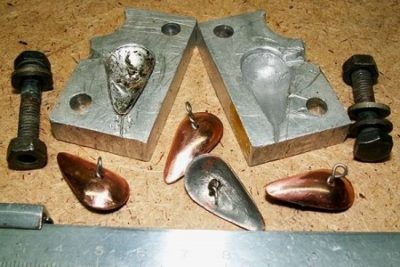
sawing is the easiest way. Various rods, tubes, pieces of copper, steel, and bronze are cut into pieces. Then the hook is soldered and various finishing treatments are performed;- soldering - a shape is cut out of copper or bronze plates and a hook is soldered. Such good jigs can be obtained by filling copper spirals with lead;
- casting - the beginning of work begins with the preparation of a jig mold for pouring molten metal. For this, chalk, plaster, and brick are used. After filling the mold, wait for the finished bait to cool and then begin processing it.
When casting and soldering, personal protective equipment must be used.
Rarely used gear for carp
The nod is the most important component of the equipment. You can buy a ready-made nod in fishing stores, but it is much more pleasant to use a nod made by yourself. No matter how rigid the rod is, no matter how tightly you hold it in your hands, the top of the rod still vibrates. And the wind constantly makes it “shake.” With small nods, those that are not difficult to find in stores, fishing with a jig is very difficult.
The material for their production must be springy, for example a regular plastic clamp. The sensitivity of the nod depends on its thickness and length. A long nod perfectly conveys accurate carp bites, and with a short nod its top shakes chaotically. With a significant length of the nod, the bite is longer and “stretched out” in time, which allows the carp angler to react correctly and without delay. Another positive feature of this nod is its inertia.
- Carp fishing in summer
- Carp fishing in summer
- Carp fishing in summer
It is quite enough to provide a long nod with a single ring - a tulip. In front of it, for optimal visibility of the bite, you need to attach a hard bead, borrowed from a purchased short nod. Many people believe that a long nod should be equipped with intermediate rings, but this opinion is erroneous. It is also very important how the nod is attached to the rod. The fastening must be strong and light. It should not weigh down the top of the rod - otherwise the rigid structure will be broken and it will bend and play in the hands.
A rod for fishing with a jig with a side nod should be about 4 meters long. It is imperative to use a reel and rings. The main requirement for a reel is reliability. When using a spinning reel, you need to tighten the clutch all the way, otherwise the carp may go into the reeds and it will be almost impossible to pull it out. You need to wind the cord onto the reel. It is recommended to select the thickness of the cord depending on the intended production. It should be noted that this tackle is great for catching both small crucian carp and trophy carp.
It’s extremely difficult to say something new in carp fishing. One of the unusual options for summer carp fishing is fishing with a jig. There are two main options for such fishing - using fairly long rods equipped with a side nod, and the use of nanojig spinning rods. When fishing with a tackle with a side nod, the jig hook can be hooked mainly with bait of animal origin - bloodworms and maggots.
But in the nanojig version, they mainly use either pieces of silicone baits or artificial bloodworms. Both methods can hardly be called popular, but fishing for even the smallest carp using delicate nanojig tackle can bring a lot of pleasure to a jig fishing enthusiast.
DIY jigs for carp
Catching carp in winter with a jig.
have had experience in catching carp and crucian carp with a jig in winter since 1994. The maximum catch in wild ponds reached 15 kilograms per day - two carp (3 kg and 700 grams) and the rest - two hundred grams of crucian carp. But in 1997 I got a job. Her specificity made it possible to frequently visit fish farms. So at the end of 1997 I made my first attempt. December. Frost around ten. The two of us saw one ruff bite and that was it. In February the whole pond was riddled with zero. I caught one perch in the shallows. The watchman, a dry little man, stated the fact that no one fishes here in winter, and I’m wasting my time. To which I replied that I would certainly try again a little later, since should still be caught with a jig in the winter
At the beginning of March, a thaw set in and everything began to flow. The boss arranges a fishing trip for Wednesday. I wake up - it’s raining, but there’s nowhere to go, - fishing is ordered - I have to go. I take a second set of clothes, an umbrella, jump into the UAZ, and here I am on the pond. I drilled along the dam at different depths, drilled the mouth of the adjacent ravine, and fed all the holes with two buckets of cake. As a result, per day in the area where the ravine flows into the pond, where water was rapidly flowing from the forested hills, 3 carp and 3 crucian carp, two hundred grams each.
I come home happy - the pond is printed. I'm going there again on Sunday, hoping to have a blast. Overboard minus one. There is soft, non-creaking snow on the ice. Light south wind, cloudy. The weather is perfect. I drill into the area of the coastline in the ravine and the adjacent 20-30 meters. Depth from one and a half to two and a half meters. There are about fifteen holes every 10-15 meters. I'm feeding. Suddenly the watchman runs and forbids me to catch, since there was no call from the director today. Having made five unsuccessful runs in several holes, I leave the place prepared for fishing. It’s half a kilometer to the car, I walk up, and word by word, I start an hour-long conversation with the watchman who chased me away about fishing stories. He listened with interest, but I was in no hurry, and besides, it turned out that he knew my father well. I don’t know what ultimately influenced his decision, but it was this: “You are such an interesting, avid fisherman. On my own responsibility, I allow you to fish until five o’clock.” Which pleasantly surprised me, and I grabbed a box, a bag of cake and an empty sugar bag for fish, just in case, and went to the feeding place. I approach the last hole 20 meters from the beginning of the ravine. I put a bloodworm on the jig hook, a nod signals that the bait touches the bottom. I carry out a slow low-frequency rise, followed by a shudder of a nod, followed by a lightning-fast hook and a two-hundred-gram crucian carp flies out of the hole onto the ice with a characteristic splash. Again the jig touches the bottom, the nod is slightly bent, and after a second it smoothly rises - hooking - cutting through, it looks like a carp. I make a second attempt, again raising the nod, hooking, the rod whip bends as much as possible. I quickly loosen the reel with a screw, throw the fishing rod to the side, the 0.15 fishing line quickly slides between my thumb and forefinger, rushing into the cold abyss of water. This is carp. Heartbeats shake the whole body, as always. It takes my breath away. These are the happy moments that we, fishermen, patiently wait for and are ready to do anything for. Meanwhile, the force of resistance weakens and the right hand drops the first meter of fishing line onto the soft velvety snow. The left one at this moment slowly goes up, again waiting for help from the right one. So, either handing over the fishing line or choosing it back, the process of saving the fishing line from breaking occurs. As a result, after about seven minutes of such a struggle, my hook pulls out of the hole into the white sparkling snow a three-kilogram yellow beauty with burning bright red fins. There is a beginning. Ten minutes of fishing - crucian carp and crucian carp.
All. The hole needs to rest - I move to another one, located on the central line of the ravine, about ten meters from the shoreline to the middle of the pond. I lower the jig with a bunch of bloodworms, barely signaling that the jig has touched the bottom, the nod lazily rises... After five minutes of the process described above, the hook again drags out the carp, whose weight is two kilograms.
The heart gradually calms down again. I decide to change the fishing rod with a thicker fishing line - 0.2 (yellow seven-year-old Japanese that has not lost its quality).
I move on to the first hole - five crucian carp and a kilogram carp. I come back - 2.5 kg of carp.
Now I’m moving along the center line of the ravine to the level of the coastline. A similar rise of the nod follows, the line goes out and goes out, I note the time - 11.20. The fishing line has stopped, but it does not move, it is kept in one position + - 20 cm. Here it dawns on me that the carp at this moment is moving in a circle with a radius equal to the length of the fishing line. In our case, about ten meters. Every two or three minutes the radius decreases and the fish gradually gives up, circle by circle. But suddenly, at 11.40, out of the blue, there was a gathering.
I start checking all the other holes, each of which contains either crucian carp or carp up to a kilogram. There are no more large ones. Therefore, my intuition pushes me to check the hole where the derailment took place.
Again, twenty minutes of struggle and already in the hole the weak pike hook fails and the jig flies into my forehead, and the carp slowly sinks and leaves. Annoyance and disappointment overcome me, but on the third attempt I still caught a carp weighing 3,600 from this hole. And the resistance was like that of a five-kilogram one.
So I frolicked, not noticing the time. And at three o'clock the watchman came and, seeing the amount of fish - half a bag, broke his promise and suggested ending it there.
Having given the watchman a bottle of vodka and a dozen crucian carp for the pleasure, I, tired and satisfied, returned home to the monotonous hum of my UAZ. Fishing for carp in winter was a success.
Making jig tackle with a side nod
The fundamental element of the equipment is the nod. This accessory plays the role of a signaling device and an auxiliary tool for playing with bait. Fishing with a jig can be done using two types of nod - straight and side. A direct nod is placed in continuation of the quivertype. The side view of the accessory is installed using a connector, perpendicular to the tackle form.
The signaling device is made of lavsan or a spring elastic flat strip.
The length of the nod directly depends on the length of the tackle. The longer the tackle, the longer the nod. Otherwise, it will be inconvenient for the fisherman to record bites at a long distance. As a rule, nods are used from an initial size of 20 centimeters and as the meters on the rod increase, so do the centimeters of the nod. The width of the 10 mm tip increases towards the base of the alarm, reaching 30 mm in the connector.
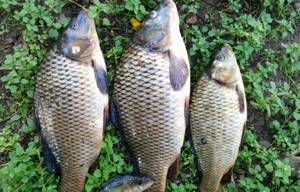
On a seven-meter fishing rod, a 30 cm alarm is quite common. The rigidity of the accessory depends on the mass of the bait. The heavier the load, the harder the material of the alarm. To make the nods visible, their tips are painted in a catchy and bright color. Practice shows that the scarlet color of the tip, combined with the white color of the main surface of the alarm, is most clearly visible above the surface of the water, without tiring the fisherman’s eyes.
Groundbaits
Carp eat quite a lot in summer, which means that you should prepare for the fact that you will need a lot of bait. It is quite difficult to overfeed this fish in warm water. The composition of baits can include a wide variety of components:
- Corn and wheat groats.
- Peas.
- Oatmeal or corn flakes.
- Semolina.
- Powdered milk.
- Canned peas and corn.
- Cookies, breadcrumbs.
- Sunflower cake.
- Bait boilies and pellets.
As a rule, each specific reservoir has its own proven compositions that work best. Carp gets used to this composition, and may be wary of anything new (although sometimes on the contrary, adding any new components can give a good result).
Important! In the summer, adding an animal component to the bait is completely unnecessary, but if the bite is bad, you can try to improve the situation.
About baits and voles
When using an ordinary jig, mosquito larvae or so-called bloodworms, widely known to fishermen, as well as maggots and burdock worms are used as baits. The bloodworm attachment is made in the form of a panicle of three or five larvae. The maggot is strung on a hook in a single version. Burdock is placed in the amount of three pieces.
Also of great interest to fish is the use of caddis flies as decoys; among fishermen this larva is known as shitik. Bites on the side nod are marked by bending the accessory towards the water. This action is of a pronounced nature with a distinct impact on the rod blank of the force from the attack of the fish. No cutting is required for this type of hunting. The fish hooks itself when it picks up the bait.
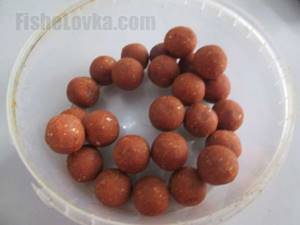
Photo 2. Carp boilies.
During summer fishing, it can sometimes happen that the usually working summer vegetable baits do not attract carp. Then you can try fishing with a “sandwich” - a combination of plant and animal components, for example, adding maggot to corn.
Of no small importance is how the nozzle will be attached to the hook, and what buoyancy it will have. The most popular among carp anglers are various types of hair rigs, which not only make the hook invisible to the fish, but also have a self-hooking effect. The location of the nozzle in relation to the bottom also matters. So, in muddy areas it is worth using floating boilies, which raise the hook above the mud, prevent it from falling into the mud, and also make the bait more visible at the bottom.
How to fish with a jig
A jig is a hunting projectile for hunting in underwater thickets. The search for promising places can occur in both standing and flowing reservoirs with an intense degree of underwater thicket formations. As a rule, the depths of such reservoirs rarely exceed 3–5 meters, but the locations of free windows and openings can be near the coastlines and at distant distances from them. For certain hunting conditions, either a swimming device in the form of a boat or an inflatable raft, or the use of waterproof overalls like waders or ordinary high waders can be used.
From the shore, the supply of jigs to the trophy extraction points is carried out by selecting effective lengths of gear. The jig season in open water is considered to be all summer and autumn months, right up to the withering of the aquatic vegetation, at the beginning of which the fish move to deeper water areas of reservoirs. The prey items are all white fish, perch and ruff. The most popular fishing among summer jigs is crucian carp, bream, roach and perch. We will discuss some fishing features in more detail in subsequent sections of the article.
When fishing from a boat, a summer jig is mounted according to the running rig principle on short rods with rings. The boat allows you to approach a specific bait supply point, and on a short length of the form it is more effective to play the bait and more clearly see the moment of biting. Approaching a clean window, the bait is lowered to the bottom and after a couple of seconds they begin to move with a rise of 5–7 centimeters and lowering back and tapping the weight on the ground.
They return to the fishing point no earlier than an hour later, repeating the algorithm of actions. A landing net with a long handle is taken into the boat, which helps to pick up the caught trophy without bringing it close to the side of the boat, thereby not scaring the rest of the fish and without exposing the equipment to entanglement in algae.
In summer, fishing with a jig from the shore can be carried out both in open and accessible windows and gaps, and near the walls of the coastal reed thicket. For the most part, blind equipment is used. Fishing carried out in a wade is effective. This way the fish is less frightened without noticing the fisherman. Having determined the fishing location, the bait is brought to the bottom and, after a short pause, pulled along the ground with a fishing rod, making a muddy path. After waiting a couple of seconds, the jig is raised about five centimeters from the bottom and an intense animation begins, which is carried out in the range of 10–15 cm vertically with intermittent amplitudes of throws.
Having not felt a bite for ten seconds, they change the horizon of the game, raising the bait by half a meter and repeat the actions, thus bringing the bait to the very surface. Having fished the entire horizon to no avail, they change place, returning no earlier than an hour for the next attempt. Before fishing, they walk along the expected trajectory of the fishing trail, choosing promising windows in advance. At successful openings, stops are made longer, repeating the game cycles more often than in unsuccessful empty places.
In still waters, more sensitive equipment with a light weight jig and a thin main line is used. Current forces do not affect the play of the bait and soft side nods from a plastic bottle most accurately signal even small bites. The load is delivered to a certain point without fear of its displacement through traction, and the playing technique is carried out purely along the vertical trajectory of lifting the rod without retracting the quiver tip.
Fishing on the current
Fishing with a jig in the summer on the current requires the use of heavy fishing tools, which is due to the resulting errors in feeding baits and, accordingly, further snags on nearby algae. When lowering the jig into a free window, they take into account the possible displacement of the load with the flow and subsequently carry out the game, constantly moving the rod opposite the movement of the flow. In such conditions they play with bait more energetically, but briefly, trying to maintain small amplitudes of movement, as if attempting to fight the insect with flowing water.
The jig is not carried out vertically, but at an angle towards the current. For signaling devices, metal nods are used, which are more rigid in structure and do not reflect the transmission of false signals from the natural forces of the current in the reservoir. Thicker lines are used. These factors reduce the sensitivity of the equipment, but increase the reliability, which is required due to frequent hooks and more stubborn struggle of the fish being caught.
Making winter jigs
In developed countries, a thing made for yourself with your own hands ( DIY , an abbreviation for “do-it-yourself”) has greater value than something purchased in a store. Because a person, when involved in the process of making something, invests in it not only his own time and money, but also something more, which then certainly brings excellent results. For professionals in fishing and fishing sports, making fishing tackle with your own hands is not only pleasant, but sometimes simply necessary.
In addition, you can make your own jig that you cannot buy anywhere. Masters bring their creations to perfection, which, however, has no limits...
Conventionally, homemade jigs can be divided according to manufacturing methods: casting, soldering, and instrumental method.
Jigs are made from lead and lead-tin alloys by casting. Soldering , jigs made of tin and its alloys with lead. Instrumentally , jigs are made from tungsten, a heavy, very hard and refractory metal.
Tungsten jigs are very difficult to make at home, or rather, impossible without the necessary machines and tools, so we will not consider this manufacturing method today.
The most creative process for making jigs is soldering. Jigs made in this way are never exactly alike, and therefore the game of each such jig is original and unique. Out of a dozen soldered jigs, there is always a favorite that catches fish better than others.
This is also the main disadvantage of homemade jigs - if the jig was not made according to a template, it will be very difficult to repeat the result. Of course, this applies not only to jigs, but also to homemade baits in general - spinners, balancers, etc.
Making jigs at home
It’s easier to show than to explain how this is done, and we found a suitable video on this topic.
Making jigs by soldering:
The video and the resulting jigs are far from ideal, but that doesn’t matter. The main thing is that the very principle of making jigs in this way becomes clear. As for the jigs from the video, its author uses too large and inappropriate hooks + rough work.
Much of the production of reelless jigs is clarified in the film by the Shcherbakov brothers - Rewindless jigs
The method of making jigs by casting is the easiest, and at the same time the most difficult. The difficulty lies in making a mold for casting, which is not always possible to make at home. However, you can purchase it or order it from a familiar locksmith. This refers to a metal form made of aluminum or its alloys. Forms made of plaster or liquid glass (stationery glue) can be made at home, but they are not durable.
Gypsum forms become stronger if the gypsum is mixed with special solutions: 3-5% solution of wood glue; 2-3% borax solution; 5-6% sugar solution.
More durable in comparison with plaster, forms are obtained based on stationery or PVA glue . To do this, talc or kaolin is mixed with one of the glues until the consistency of sour cream. Forms based on these adhesives take several days to dry.
Naturally, to make molds , you need to have a model , a prototype of the jig.
For injection molds made of plaster or glue, this can be a ready-made, catchable jig for cloning, or your own model, which is usually formed from wood or waxy materials. For aluminum molds, the model must be made of hardened metal. Because such forms are made by squeezing the model between two aluminum plates.
Mold for casting jigs: 1 - sprue; 2 - aluminum plates; 3 - needle; 4 - hook.
We won’t go into the intricacies of the technology, because anyone who wants to make such injection molds for themselves most likely already knows how.
There is also a method for making jigs by winding copper or tungsten wire around the fore-end of a curved hook, followed by tinning it using solder. But such jigs, with equal sizes, are usually lighter than solid ones. However, wrapping a solid tungsten billet with wire to improve performance properties is a completely acceptable solution.
Wrapping the jig: 1 - blank; 2 - hook; 3 - wire winding; 4 - finished jig; 5 - jig with a three-dimensional pattern.
Improving the quality and catchability of winter jigs
“Tuning”, or modernization of winter jigs . We make catchy jigs.
Most often, purchased jigs have a number of shortcomings that need to be eliminated.
The most unpleasant thing is when a high-quality tungsten jig has a worthless hook installed. Since the hooks are soldered into the body of the jig using tin alloys, this defect can be easily corrected with a soldering iron by replacing the hook with a better one.
Replacing a hook in a lead or tin jig is practically impossible, so when purchasing, you need to immediately pay attention to the quality of the hook. A good hook should be moderately thin, very sharp, and proportionate to the body of the jig itself.
Changing the shape of the jig - “flat”. The most common improvement to a round or drop-shaped tungsten jig is to grind off the top of the jig from the hook to its center or hole (a flat is the ground off edge or cut of a cylindrical piece). This is done using an emery machine, or manually, with a diamond file.
The next upgrade is to install a cambric into the hole of the jig. Tungsten jigs easily cut the line with the sharp edges of the hole, without any strong tension. To avoid losses, it is necessary to either form a special loop from a braided fishing line, or install a jig or plastic cambric in the hole. How this is done can be clearly seen in the following video, and read: how to tie a jig.
Installing a cambric into a jig:
Another improvement is to improve the attractiveness of the jig, not only from the aesthetic point of view of the fisherman, but also its working properties - catchability. Everything is quite simple here. If you are not satisfied with the natural metallic shine of a tungsten jig, the jig can be painted by dipping it into the desired color of varnish or paint that is not afraid of water and has good adhesion (adhesion) to the metal.
To turn an ordinary jig into a no-attachment jig, also called a reelless jig , or a reelless jig , you need to hang something movable on the shank of the hook that creates additional noise under water. These can be colored cambrics, beads, wool. Although, you can successfully catch without any attachments at all, due to the technique of playing with a jig.
Features of fishing in summer by month
Fishing for carp in June is quite simple, since the beginning of June, as a rule, marks the end of the spawning of this fish. At this time, he somewhat loses his caution and can actively peck even at those baits to which in just a month he will not pay any attention. During this period, almost all possible options for bait and bait can be actively used. You should look for carp near dense aquatic vegetation, next to snags, or under a wall of reeds.

Photo 3. Behind this wall of reeds is a promising carp spot.
July is a slightly more difficult month for carp fishing. The post-spawning period has long passed, there is enough food in the reservoir at this time, so the fish will treat the proposed bait with caution. At this time, you should look for carp in shallow areas of the reservoir next to aquatic vegetation. Fishing at night can bring good results. At this time, mainly vegetable baits are used.
August
August is also a comparatively more difficult time for carp fishing. Its location on the reservoir at this time largely depends on weather conditions. In warm weather, it is found in shallow water areas, and the further the shallow water is from the shore, the more promising the fishing point. In hot weather, it can also hide in the shade of reeds or trees.
https://www.youtube.com/video/laa2tqZLK5I
Important! When the air temperature is too high, carp practically do not bite; you can expect activity from this fish in such conditions only at night.
Rules for catching carp in winter
It should be immediately clarified that carp fishing in winter is not possible in every body of water. A prerequisite is the presence of a sufficient amount of oxygen in the water column under the ice. Otherwise, the activity of the carp will really decrease and it will not respond to the bait (Figure 1).
Note: Of course, you can go on a paid fishing trip to reservoirs that are artificially saturated with oxygen using compressors. But it is much more interesting to find a natural dam or river with a dam where this fish can settle.
When going in search of a winter camp for carp, you should also take into account the water temperature, because this fish prefers to be located in the warmest areas of the bottom. In fact, the warmest water, with a temperature around zero, is located in the upper layer of the water column, almost at the very ice crust. However, this fish can not always be found near the surface.

Figure 1. Even in frosty winter, large carp are caught quite well
Good places for carp fishing are:
- Areas of the pond of medium depth, where active growth of aquatic vegetation is observed in summer.
- Overgrown places, snags and deep-water holes.
- The edges of the reservoir, which in the warm season are covered with abundant vegetation.
- Sections of a river or pond into which streams of relatively warm water constantly flow.
Finding a carp site can be simplified if you spend time exploring the reservoir in the summer. As a rule, in winter fish bite in the same places as in summer. However, if this is your first time visiting a particular body of water, you will have to look for fish sites using echo sounders or on the advice of local fishermen.
When going winter fishing for carp, you cannot ignore the habits of this fish. It has a rather violent temperament, and quite often breaks gear or even drags light fishing rods to the bottom. But this behavior is typical only for summer. In winter, due to the low temperature of the water and the decrease in oxygen concentration in it, the activity of the carp decreases, although it continues to feed. Taking into account all these features, you need to choose the right gear and bait to which the carp is guaranteed to react.
